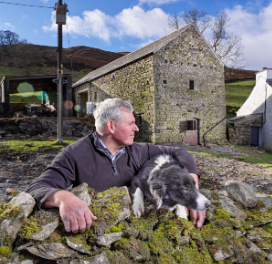
A Lake District barn in Longsleddale is amongst the first in the country to benefit from a pilot grant to sensitively repair the building for continued agricultural use and to preserve the appearance of the surrounding cultural landscape.
The Grade II listed traditional bank barn dates back to 1741 and has been on the Lake District National Park’s ‘buildings at risk’ register since 2010. The barn has undergone specialist conservation work including repairs to the roof, walls and internal joinery, with new rainwater goods added to help protect the building from the worst of the Cumbrian weather.
This innovative pilot grant scheme has provided the National Park and barn owner Andrew Sutton with the ideal opportunity to have the building sensitively repaired and brought back into use as part of the farm holding as additional stock housing and hay storage.
Rose Lord, the Lake District National Park’s Strategy and Partnership Adviser said: “We warmly welcome this initiative and are delighted to be working in partnership with local farmers and building owners to ensure that we can conserve these iconic buildings and support their continued agricultural use.
“Traditional farm buildings are an integral part of our working landscape and this scheme recognises the significant heritage value that these types of buildings have for Lake District communities and which are also so very important for our World Heritage Site status.
“This particular project has resulted in a Grade II listed bank barn being brought back into use and with regular maintenance the building can continue to be used by many generations to come.”
The project involved conservation accredited architects, Countyside Consultants based in Alston and experienced building contractors T A Law from Ravenstonedale. There are ten other sites taking place in the scheme from the Lake District National Park and as the scheme is a pilot, it is now closed to new applicants but existing applicants can submit restoration grant applications up until 30 March 2020.
The £8 million Historic Building Restoration Grant Pilot is a collaborative project between Natural England, Historic England, Rural Payments Agency and five National Parks (Dartmoor, Lake District, Northumberland, Peak District and Yorkshire Dales).
Rural Affairs Minister Lord Gardiner said: “This pilot is a wonderful initiative to help bring historic buildings back to life for future generations. Many of the historic stone barns scattered throughout our National Parks have fallen out of use, despite being perfectly situated to provide shelter for livestock or store feed. Natural England has played an important role in helping applicants with the application process, and I look forward to seeing how this funding will be spent to revitalise these buildings.”
Sir Laurie Magnus, Chairman of Historic England said: “We are delighted at the results already being demonstrated by the historic farm building restoration grant pilot scheme. They show the widespread enthusiasm to repair these buildings which are such a distinctive part of their landscapes. Historic England will continue to work in partnership with the National Parks, landowners and tenants, Natural England and the Rural Payments Agency to ensure as many historic farm buildings as possible can be brought back into use.”
Our photos are courtesy of James O. Davies at Historic England and show Andrew Sutton outside the barn and some of the work that’s already taken place inside the building.